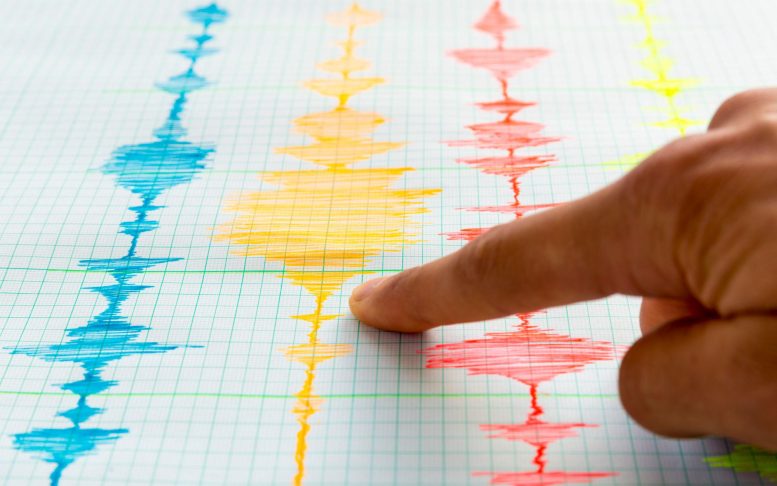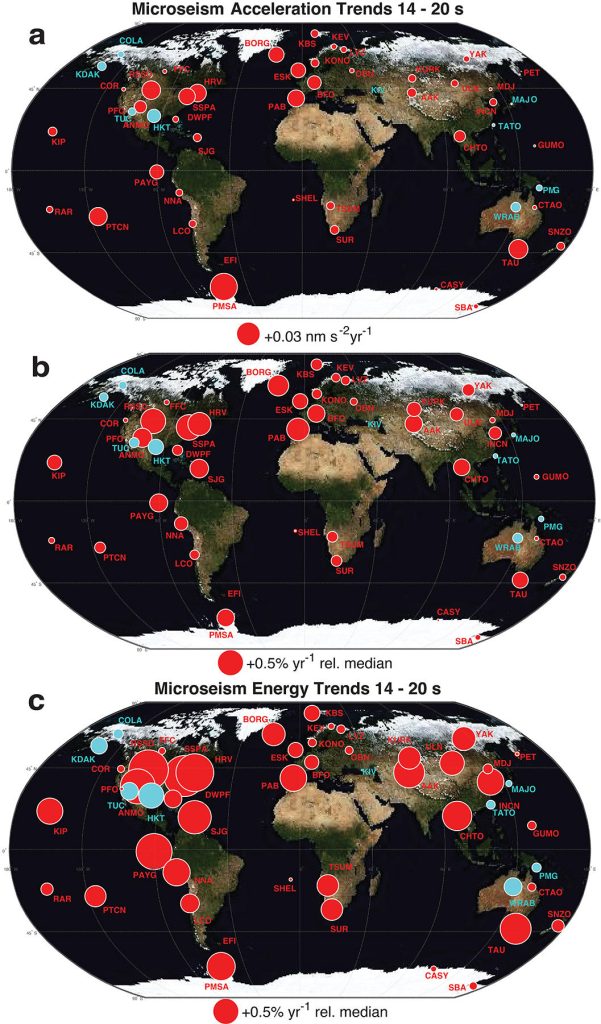
Since the 1980s, seismic stations have been detecting an increase in ocean wave intensity, correlating with climate change. A Colorado State University study, analyzing over 35 years of data, found that ocean waves have become significantly stronger, reflecting an increase in storm severity due to global warming. This seismic data, revealing long-term trends and changes in wave energy, underscores the need for resilient strategies to protect coastal areas from the impacts of climate change.
Since the late 1980s, contemporary digital seismic stations globally have been monitoring the Earth’s vibrations. Previously deemed as mere background disturbance by seismologists, the persistent low hum generated by ocean waves has been growing stronger since the late 20th century, according to a study led by Colorado State University.
The study, published in Nature Communications, examines data from 52 seismic stations recording the motions of the Earth once per second for more than 35 years. This decades-long record supports independent climate and ocean research that suggests that storms are intensifying as the climate warms.
“Seismology can provide stable and quantitative measures of what’s going on with the world’s ocean waves and complements studies using satellite, oceanographic, and other methods,” said lead author Rick Aster, a CSU geophysics professor and head of the Department of Geosciences. “The seismic signal is both consistent with these other studies and shows the sorts of features that we may expect from anthropogenic climate change.”
Aster and his co-authors with the U.S. Geological Survey and Harvard University studied the primary microseism – a seismic signal created by large, long-period waves as they roll across shallower areas of the global ocean. The seafloor in coastal regions experiences the constant push and pull of these waves, and these pressure variations generate seismic waves that are picked up by seismographs.

Seismic station locations and global trends since the late 1980s (red positive, cyan negative) for (a) vertical ground acceleration amplitude (in billionths of a meter), (b) acceleration amplitude normalized by its historical median, and (c) seismic energy normalized by its historical median. Credit: Rick Aster
Seismographs are best known for monitoring and studying earthquakes, but they also detect many other things, including glacial movements, landslides, volcanic eruptions, large incoming meteors, and noise from cities. Seismic waves from diverse forces on the surface or inside the Earth can be identified at great distances, even in some cases on the opposite side of the world.
“As the atmosphere and ocean become warmer, they contain more energy, so storms become more intense, and storm-driven ocean waves increase in size and energy,” Aster said. “Increasingly energetic ocean waves directly increase the intensity of seismic waves.”
Making (bigger) waves
Seismic signals showed that waves in the notoriously stormy Southern Ocean around Antarctica were, predictably, the most intense on the planet, but North Atlantic waves have intensified the most rapidly in recent decades, reflecting intensifying storms between eastern North America and western Europe.
Multi-year climate patterns like El Niño and La Niña, which influence the strength and distribution of global storms, also can be observed in the data, in addition to a steady climb in wave energy that mirrors the widespread increase in global ocean and air temperatures and larger storms.
“It’s clear that we’re seeing the general signal of storm activity around the world in these long-term seismic records in addition to a long-term intensification, attributed to global warming,” Aster said. “It seems like a small signal from year to year, but it’s progressive and becomes very clear when you’ve got 30-plus years of data to work with.”
Aster and his colleagues found that globally averaged ocean wave energy has increased at a median rate of 0.27% per year since the late 20th century and 0.35% per year since January 2000.
Stormy forecast
Aster said bigger waves and bigger storm-related surges, combined with rising sea levels, are a serious, global issue for coastal ecosystems, cities, and infrastructure.
“We’re going to have to implement resilient strategies, as well as to try to mitigate climate change itself, to ensure that our coastal populations and ecosystems are going to be protected from an increasingly stormy future,” Aster said.
Reference: “Increasing ocean wave energy observed in Earth’s seismic wavefield since the late 20th century” by Richard C. Aster, Adam T. Ringler, Robert E. Anthony and Thomas A. Lee, 32 October 2023, Nature Communications.
DOI: 10.1038/s41467-023-42673-w
The study was funded by the U.S. Geological Survey and the National Science Foundation.









Oh no. Climate change in the atmosphere, is causing an increase in storm intensity, is causing ocean surface ocean wave changes, is causing seismic waves? Please. “30-plus years of data” might establish a climate, maybe not. Establish that first, then establish it changed, then find a cause to attribute it to. There isn’t the data yet to know the normal seismic noise over a 30+ year climate, let alone say it’s increasing, let alone…didn’t they just install these oceanic sensors during the cold war to detect nuclear explosions and submarines? The chart in the study starts at 1990!
The study says this is Rayleigh waves, caused by surface ocean water waves. The weak ground roll caused by maybe a hurricane shows up on sensors, mostly microseim Love waves and noise, but we don’t know what’s normal yet geologically. Translating the weather’s timescale into a more geologic timescale to look for a short-term climate change? Using seismic sensors as a proxy for oceanic state, as a proxy for wave intesity, as a proxy for the weather change, as a stand-in for climate, to try to establish a change of climate in 34 years? I’m not a seismologist at all, but they’re going to make them cry. Not to mention the TV news is going to say climate change causes earthquakes.
Well… surf’s up!